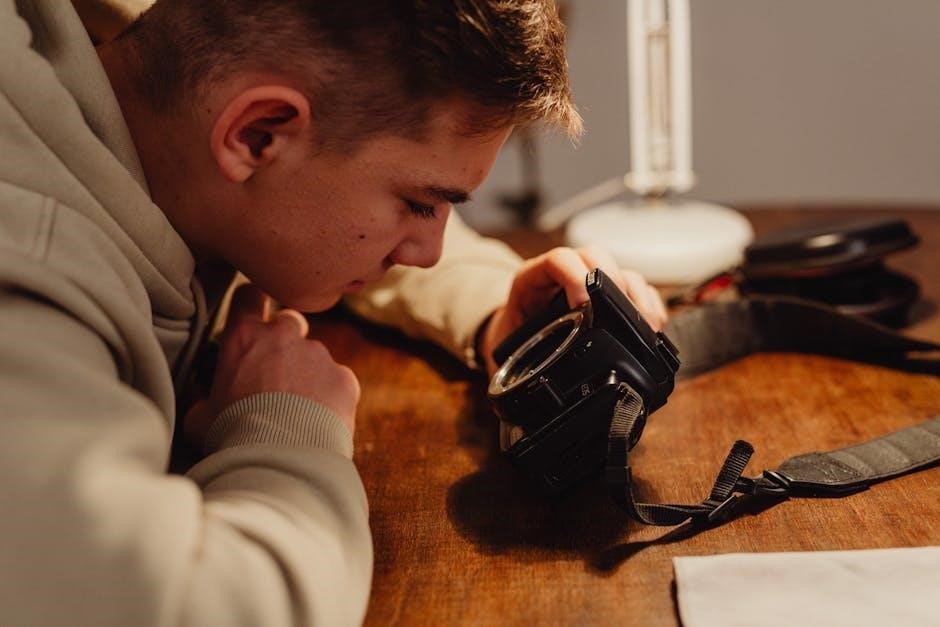The NCLE certification is a professional credential for opticians and contact lens technicians, ensuring competence in fitting, dispensing, and managing contact lenses. It validates expertise through a rigorous exam.
1.1. Overview of the NCLE Exam
The NCLE exam is a comprehensive assessment designed to evaluate the skills and knowledge of contact lens technicians. It covers key areas such as diagnostic lens selection, fitting characteristics, and patient care. The exam consists of multiple-choice questions and case studies, testing both theoretical and practical expertise. Candidates are allotted a specific time to complete the exam, ensuring they demonstrate their ability to handle real-world scenarios effectively. The exam is regulated by professional standards, making it a trusted credential in the field. Proper preparation, including study guides and practice tests, is essential for success. The NCLE exam is a critical step for those seeking to advance their careers as certified contact lens examiners.
1.2. Importance of NCLE Certification for Contact Lens Technicians
The NCLE certification is a critical credential for contact lens technicians, demonstrating their expertise in fitting, dispensing, and managing contact lenses. It enhances professional credibility and trust with patients, ensuring safe and effective lens care. The certification is often a requirement for advanced roles in optometry and ophthalmology practices. By obtaining the NCLE certification, technicians validate their knowledge of contact lens materials, designs, and troubleshooting, which is essential for patient satisfaction and outcomes. It also opens up career opportunities and signifies a commitment to staying updated on industry standards and best practices. Ultimately, the NCLE certification is a mark of professionalism and competence in the field of contact lens care;

Diagnostic Lens Selection and Handling
Diagnostic lens selection and handling are crucial for accurate contact lens examinations. Proper techniques ensure patient comfort, precise fitting, and effective troubleshooting, essential for NCLE certification.
2.1. Selecting Initial Diagnostic Lenses
Selecting initial diagnostic lenses involves evaluating patient-specific factors such as refractive error, corneal curvature, and lifestyle needs. The process begins with determining the base lens parameters, including power, diameter, and material, to ensure optimal fit and comfort. Initial lenses are often chosen based on average values, but adjustments may be necessary for unique cases. Proper selection is critical for accurate fitting and troubleshooting. Understanding lens design, such as aspheric or spherical profiles, is also essential. This step ensures the lenses align with the patient’s ocular anatomy, minimizing discomfort and maximizing visual clarity. The NCLE exam emphasizes mastering this skill to provide effective patient care and achieve successful outcomes in contact lens fitting.
2.2. Identifying Defects in Contact Lens Material or Design
Identifying defects in contact lens material or design is crucial for ensuring patient safety and optimal performance. Common defects include surface scratches, edge defects, and material discoloration, which can compromise lens durability and comfort. Technicians must also inspect for design flaws, such as incorrect base curve or power, which can lead to improper fit and visual disturbances. Detecting these issues requires meticulous examination using tools like slit lamps or magnifiers to assess lens integrity and accuracy. Failure to identify defects may result in patient discomfort, vision problems, or even eye health risks. Understanding material properties and design specifications is essential for troubleshooting and ensuring high-quality patient care.
2.3; Inserting, Removing, and Manipulating Diagnostic Lenses
Mastering the techniques for inserting, removing, and manipulating diagnostic lenses is essential for accurate patient assessments. Proper insertion ensures the lens is centered and moved correctly, while removal requires care to avoid discomfort or corneal damage. Manipulation involves aligning the lens for optimal fit and visual performance. Using tools like slit lamps, technicians observe lens movement, centration, and edge alignment to ensure proper positioning. Maintaining hygiene and handling lenses gently prevents contamination and extends their lifespan. These skills are critical for evaluating fitting characteristics and patient comfort, ensuring precise diagnostic outcomes and effective patient care.
Contact Lens Fitting and Performance
Contact lens fitting involves evaluating centration, movement, and edge alignment to ensure proper positioning on the eye. This step is crucial for optimal visual acuity and comfort.
3.1. Evaluating Fitting Characteristics
Evaluating fitting characteristics involves assessing how the contact lens interacts with the eye. Key factors include centration, movement, edge alignment, and overall stability. Proper centration ensures the lens is centered over the pupil, while adequate movement allows for tear exchange. Edge alignment should be smooth to avoid discomfort. Using a slit lamp, technicians observe these characteristics, ensuring optimal fit. Improper fitting can lead to discomfort, blurred vision, or even eye health issues. Fluorescein staining may be used to assess lens positioning and tear flow. Understanding these principles is critical for achieving a successful fit, balancing both patient comfort and visual performance. This step requires precise observation and adjustment to ensure the lens meets the eye’s unique needs.
3.2. Assessing Visual Performance
Assessing visual performance is crucial to ensure the contact lenses meet the patient’s visual needs. This involves evaluating visual acuity, both near and far, to confirm sharpness and clarity. Testing under different lighting conditions helps determine adaptability. Additionally, examining the peripheral vision ensures no obstructions. Addressing any distortions or glare is essential for optimal visual comfort. Patient feedback on clarity, brightness, and overall satisfaction is gathered to refine lens selection. Visual performance assessment ensures the lenses not only fit well but also provide clear, comfortable vision, meeting the patient’s lifestyle demands. This step bridges the technical aspects of fitting with the practical outcomes of lens wear, ensuring a successful outcome for both the patient and practitioner.
3.3. Refining Lens Parameters for Optimal Fit
Refining lens parameters is essential to achieve an optimal fit and ensure patient comfort. Adjustments may include modifying the power, diameter, or axis to align with the patient’s corneal shape and vision needs. Evaluating lens movement, centration, and stability is critical to prevent complications. The lens material and design should be tailored to address specific issues like astigmatism or presbyopia. Fine-tuning these elements ensures proper oxygenation and reduces the risk of discomfort or irritation. Regular follow-ups are necessary to monitor adaptation and make further adjustments as needed. This step-by-step refinement process ensures the lenses not only fit correctly but also meet the patient’s visual and comfort requirements, enhancing overall satisfaction and wearability.

Dispensing and Patient Care
Dispensing involves providing lenses tailored to patients’ needs, ensuring proper fit and vision. Patient care includes educating on hygiene, wear schedules, and addressing concerns to promote safe usage.
4.1. Wearing Schedules and Patient Education
Effective patient education is crucial for successful contact lens wear. This includes discussing proper hygiene, lens care, and adherence to prescribed wearing schedules. Patients should be informed about the risks of improper lens use, such as extended wear without proper cleaning, which can lead to complications like infections or discomfort. Educational materials often emphasize the importance of following the recommended replacement schedule for lenses, whether daily, weekly, or monthly. Additionally, patients should be taught how to handle and store lenses safely, including the use of appropriate cleaning solutions. Clear communication ensures patients understand their responsibilities, enhancing both comfort and safety. Proper education also addresses common misconceptions and promotes compliance with professional recommendations.
4.2. Dispensing Procedures and Documentation
Dispensing procedures involve ensuring that contact lenses are accurately fitted and issued to patients, with clear verification of lens specifications. Proper documentation is essential, including detailed records of lens type, power, and wearing schedule. Accurate documentation ensures continuity of care and legal compliance. Dispensing opticians must maintain thorough patient records, including initial evaluations, follow-up assessments, and any adjustments made to the prescription. This documentation also serves as a reference for future appointments and helps in troubleshooting fitting issues. Additionally, it is crucial to document patient education provided, such as lens care instructions and wearing guidelines. Clear and precise records help minimize errors and ensure that patients receive the correct lenses, aligning with professional standards and legal requirements. Proper documentation is a cornerstone of responsible contact lens dispensing.
Patient Evaluation and Response
Evaluating patient comfort and assessing visual performance are critical for successful contact lens fitting. Accurate documentation ensures continuity of care and legal compliance, enhancing patient outcomes and satisfaction.
5.1. Assessing Patient Comfort and Discomfort
Assessing patient comfort involves evaluating subjective feedback, such as sensations of dryness or irritation, and objective signs like redness or tearing. Proper evaluation ensures optimal lens fit and minimizes complications. Techniques include patient interviews, slit-lamp examinations, and monitoring corneal health. Addressing discomfort promptly enhances patient satisfaction and adherence to lens wear. This step is crucial for maintaining long-term ocular health and ensuring successful contact lens use; Documentation of findings is essential for legal compliance and continuity of care. By understanding patient responses, technicians can refine lens parameters and recommend appropriate solutions, fostering trust and improving outcomes. This process underscores the importance of effective communication and clinical expertise in contact lens care.
5.2. Evaluating Visual Acuity and Satisfaction
Evaluating visual acuity and patient satisfaction is critical to ensure the effectiveness of contact lens fitting. Visual acuity tests, such as Snellen charts, assess sharpness and clarity of vision with lenses. Satisfaction is determined through patient feedback on vision quality, comfort, and lifestyle adaptability. Both objective and subjective measures guide adjustments to lens parameters. High satisfaction correlates with better compliance and long-term success. This step ensures that the lenses meet the patient’s visual and comfort needs, reinforcing the importance of precise fitting and patient communication. Proper evaluation enhances patient trust and outcomes, making it a cornerstone of contact lens care.
Contact Lens Materials and Designs
Contact lens materials, such as silicone hydrogel and rigid gas-permeable, offer varying oxygen permeability and comfort. Designs like aspheric and multifocal enhance visual performance for specific needs.
6.1. Types of Contact Lens Materials
Contact lens materials vary in properties and applications. Silicone hydrogel lenses offer high oxygen permeability, promoting eye health and comfort for extended wear. Rigid gas-permeable (RGP) lenses provide durability and sharp vision but require adaptation. Daily disposable lenses, made from hydrogel or silicone hydrogel, combine convenience and hygiene. Traditional hydrogel lenses are cost-effective but less breathable. Each material caters to specific needs, such as astigmatism or presbyopia, ensuring optimal fit and visual clarity. Understanding these materials is crucial for technicians to recommend the best options for patients, balancing comfort, vision quality, and lifestyle demands.
6.2. Advantages and Disadvantages of Different Lens Designs
Contact lens designs vary to address specific vision needs, each with unique benefits and drawbacks. Spherical lenses correct nearsightedness and farsightedness but may not address astigmatism. Toric lenses, designed for astigmatism, provide clear vision but can rotate or destabilize. Multifocal lenses offer convenience for presbyopia by combining multiple focal points, though adaptation can be challenging. Aspheric lenses reduce aberrations, improving vision in low light, but may not suit all prescriptions. Each design balances comfort, visual clarity, and adaptability, requiring careful selection based on patient needs and lifestyle. Understanding these trade-offs is essential for technicians to tailor solutions effectively.

Complications and Troubleshooting
Recognizing common complications like infections, discomfort, and vision clarity issues is crucial. Troubleshooting involves identifying root causes, such as improper fit or material incompatibility, and resolving them effectively.
7.1. Common Complications Associated with Contact Lens Wear
Contact lens wear can lead to various complications, including microbial infections, corneal ulcers, and discomfort. Improper hygiene or lens misuse often causes these issues. Common problems include microbial keratitis, a serious infection requiring immediate treatment, and corneal abrasions, which can result from improper lens removal. Additionally, dry eye syndrome and allergic reactions are frequent complaints, often due to lens material incompatibility or environmental factors. Vision disturbances, such as blur or glare, may also occur from lens deposits or improper fit. Addressing these complications promptly is essential to prevent long-term damage and ensure patient comfort and safety. Proper patient education on lens care and regular follow-ups can mitigate many of these issues.
7.2. Troubleshooting Fitting Issues
Troubleshooting fitting issues involves identifying and addressing problems related to contact lens fit and performance. Common issues include poor centration, insufficient movement, and improper axis alignment in toric lenses. Symptoms like blurred vision, discomfort, or lens awareness often indicate a fitting problem. To resolve these, technicians may refine lens parameters such as base curve, diameter, or power. Assessing the lens-to-cornea relationship and evaluating tear film interaction are critical steps. Utilizing diagnostic tools and patient feedback can guide adjustments. Regular follow-ups ensure optimal fit and prevent complications, enhancing both visual acuity and patient satisfaction. Effective troubleshooting requires a systematic approach and thorough understanding of lens mechanics and ocular anatomy.

Legal and Ethical Considerations
Understanding legal and ethical considerations is crucial for professionals to meet standards, respect patient rights, ensure informed consent, maintain privacy, and comply with regulations in contact lens care.
8.1. Professional Responsibilities and Liabilities
Contact lens professionals must adhere to legal and ethical standards, ensuring accurate assessments, proper lens fitting, and patient education. They are liable for negligence or non-compliance with regulations. Maintaining patient confidentiality and obtaining informed consent are critical. Professionals must stay updated on industry standards and documentation requirements to avoid legal repercussions. Proper record-keeping and adherence to ethical practices protect both patients and practitioners. Understanding these responsibilities is essential for providing safe and effective care.
8.2. Ethical Practices in Contact Lens Examination
Ethical practices in contact lens examination involve upholding integrity, transparency, and patient-centered care. Professionals must avoid conflicts of interest and ensure unbiased recommendations. They should maintain patient trust by being honest about lens suitability and potential risks. Adhering to evidence-based guidelines ensures reliable outcomes. Confidentiality and respect for patient autonomy are paramount. Ethical decision-making also includes reporting adverse reactions and ensuring proper handling of medical devices. These practices foster a safe and trustworthy environment for patients, aligning with professional standards and the NCLE certification goals. By integrating ethics into daily procedures, professionals contribute to advancements in eye care and maintain public confidence in their expertise.

Exam Preparation Strategies
Effective preparation involves using study guides, practice tests, and flashcards. Focus on understanding key concepts, managing time, and reviewing weak areas to ensure exam readiness and confidence.
9.1. Recommended Study Materials and Resources
Essential study materials for the NCLE exam include comprehensive study guides, practice tests, and online courses. The NCLE Study Guide offers detailed explanations and over 500 practice questions. Additionally, Carrie Wilson’s Contact Lens Specialist Course provides practical insights and 300 practice questions. Online platforms like Quizlet offer flashcards for key terms and concepts. Mock exams, such as those included in the NCLE Exam Prep, simulate real test conditions, helping candidates assess their readiness. Utilizing these resources ensures a well-rounded preparation, covering theoretical knowledge and practical skills. Prioritize materials that align with the exam format and content to maximize efficiency and confidence.
9.2. Practice Tests and Mock Exams
Practice tests and mock exams are crucial for NCLE exam preparation, allowing candidates to assess their knowledge and familiarity with the exam format. The NCLE Study Guide includes 500 practice questions and 4 full-length mock exams, mirroring the actual test experience. These resources help identify weak areas and improve time management. Additionally, Carrie Wilson’s Contact Lens Specialist Course offers over 300 practice questions, focusing on practical scenarios. Regularly taking mock exams builds confidence and reduces exam-day anxiety. Utilizing these tools ensures a thorough understanding of the material and enhances problem-solving skills. They are indispensable for achieving success in the NCLE certification process.
The NCLE certification is essential for contact lens technicians, ensuring expertise in fitting and patient care. Utilize study guides and practice exams to excel and achieve success.
10.1. Final Tips for Success in the NCLE Exam
To excel in the NCLE exam, focus on understanding core concepts like lens fitting, material types, and patient care. Utilize study guides, practice tests, and review courses to reinforce knowledge. Prioritize hands-on experience with diagnostic lenses to build practical skills. Time management during the exam is crucial, so practice under timed conditions. Stay updated with the latest industry standards and research. Engage with study groups or forums for peer support and shared insights. Lastly, maintain a structured study schedule and ensure adequate rest before the exam to perform at your best. These strategies will enhance your confidence and readiness for success.



